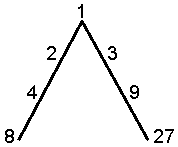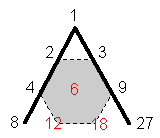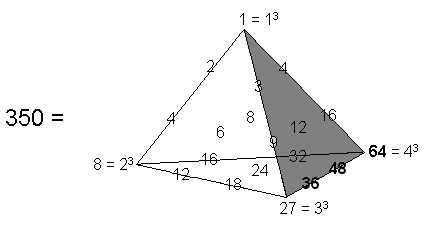


| << Previous 1... 3 4 [5] 6 7 ...9 Next >> |
#4 The Tetrahedral Lambda embodies the number 137
 |
 |
 |
| Plato's Lambda | Lambda Tetractys | The Tetrahedral Lambda |
In Timaeus, Plato's account of Pythagorean cosmology, the Demiurge mixed the three ingredients of the World Soul into malleable stuff from which He drew a strip and bent it, dividing it into portions of length given by the first four integers of two geometric series with geometric factors of 2 and 3:
1, 2, 4, 8, ..... 1, 3, 9, 27, ....
These seven integers form the "Lambda," so-called because of its resemblance to the Greek letter Lambda (Λ). They line two sides of a tetractys of 10 integers (the Lambda Tetractys), the three red integers 6, 12 & 18 that complete the tetractys being interpolated by multiplying some of the integers by the factors of 2 and 3. As every student of music knows, this pattern of integers can be expanded into an infinite lattice of "number weights" whose ratios define the tone ratios of the notes of the Pythagorean musical scale. But, despite being Plato's own version of the mathematics underlying Pythagoras' doctrine of the musical harmony of the planets' motion in the celestial sphere, this cosmological allegory suffers from a lack of Pythagorean compleness. The number weights are of the form 2p3q, where p = ±1, ±2, etc and q = ±1, ±2, etc. Missing from the successive powers of 2 and 3 that generate sequences of octaves and perfect fifths is the number 4 that completes the tetractys. True Pythagorean balance is restored by realising that the Lambda Tetractys is but the first face of a tetrahedral array of 20 integers forming four different Lambda Tetractyses, with the fourth one the base of a tetrahedron with 1 at its apex and the first three powers of 2, 3 & 4 spaced along its three upper edges. The sum of the seven, 10 and 20 number weights in, respectively, the Lambda, the Lambda Tetractys and the Tetrahedral Lambda are 54, 90 and 350. The 10 number weights forming the fourth face of the tetrahedron:
|
8 |
|||
| 12 | 16 | ||
|
18 |
24 |
32 |
|
| 27 | 36 | 48 | 64 |
now create sequences of octaves, perfect fifths and perfect fourths that are parallel to all three sides of the tetractyses, whereas the first face (Lambda Tetractys) displays only sequences of octaves and perfect fifths that are parallel to sides.
The sum of the nine powers of 2, 3 & 4 on the three edges of the Tetrahedral Lambda that converge to the integer 1 at its apex:
|
21 |
|||
| 22 | 43 | ||
|
23 |
1 |
42 |
|
| 31 | 32 | 33 | 41 |
is 137. The sum of the six powers of 2 and 3 on the two edges forming sides of the Lambda Tetractys is 53, so that the sum of the remaining three numbers 41, 42 & 43 is 84, where
84 = 12 + 32 + 52 + 72.
This is also the sum of the nine integers in the Lambda Tetractys that surround its central number 6. The meaning of their sum (90) vis-à-vis CTOL is that there are 90 Trees of Life above the lowest Tree, 84 of them being above the 7-tree that maps the physical plane, six of whose Trees are above the 1-tree.
The Tetrahedral Lambda is discussed on page 4 and later pages at the section Plato's Lambda.